Wenguan Wang
History-Enhanced Two-Stage Transformer for Aerial Vision-and-Language Navigation
Dec 17, 2025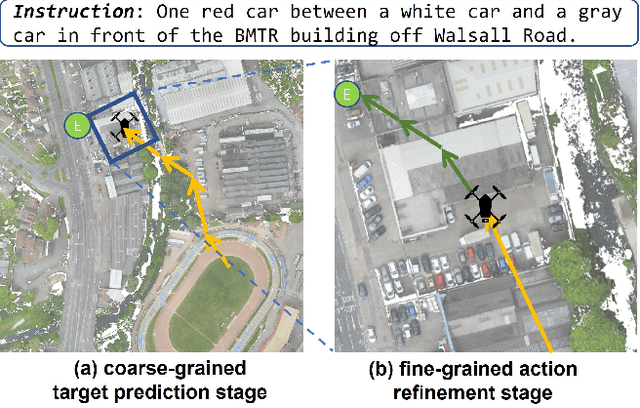

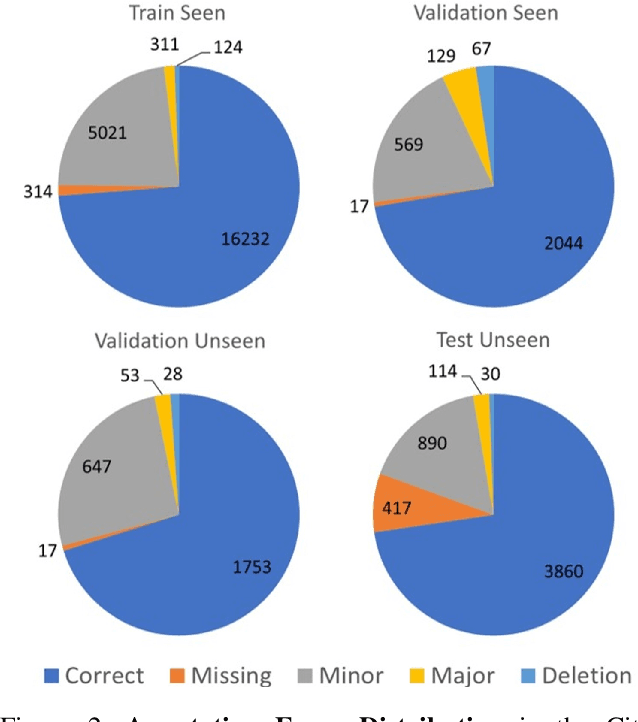

Abstract:Aerial Vision-and-Language Navigation (AVLN) requires Unmanned Aerial Vehicle (UAV) agents to localize targets in large-scale urban environments based on linguistic instructions. While successful navigation demands both global environmental reasoning and local scene comprehension, existing UAV agents typically adopt mono-granularity frameworks that struggle to balance these two aspects. To address this limitation, this work proposes a History-Enhanced Two-Stage Transformer (HETT) framework, which integrates the two aspects through a coarse-to-fine navigation pipeline. Specifically, HETT first predicts coarse-grained target positions by fusing spatial landmarks and historical context, then refines actions via fine-grained visual analysis. In addition, a historical grid map is designed to dynamically aggregate visual features into a structured spatial memory, enhancing comprehensive scene awareness. Additionally, the CityNav dataset annotations are manually refined to enhance data quality. Experiments on the refined CityNav dataset show that HETT delivers significant performance gains, while extensive ablation studies further verify the effectiveness of each component.
Moving Beyond Diffusion: Hierarchy-to-Hierarchy Autoregression for fMRI-to-Image Reconstruction
Oct 25, 2025Abstract:Reconstructing visual stimuli from fMRI signals is a central challenge bridging machine learning and neuroscience. Recent diffusion-based methods typically map fMRI activity to a single high-level embedding, using it as fixed guidance throughout the entire generation process. However, this fixed guidance collapses hierarchical neural information and is misaligned with the stage-dependent demands of image reconstruction. In response, we propose MindHier, a coarse-to-fine fMRI-to-image reconstruction framework built on scale-wise autoregressive modeling. MindHier introduces three components: a Hierarchical fMRI Encoder to extract multi-level neural embeddings, a Hierarchy-to-Hierarchy Alignment scheme to enforce layer-wise correspondence with CLIP features, and a Scale-Aware Coarse-to-Fine Neural Guidance strategy to inject these embeddings into autoregression at matching scales. These designs make MindHier an efficient and cognitively-aligned alternative to diffusion-based methods by enabling a hierarchical reconstruction process that synthesizes global semantics before refining local details, akin to human visual perception. Extensive experiments on the NSD dataset show that MindHier achieves superior semantic fidelity, 4.67x faster inference, and more deterministic results than the diffusion-based baselines.
A Conditional Probability Framework for Compositional Zero-shot Learning
Jul 23, 2025Abstract:Compositional Zero-Shot Learning (CZSL) aims to recognize unseen combinations of known objects and attributes by leveraging knowledge from previously seen compositions. Traditional approaches primarily focus on disentangling attributes and objects, treating them as independent entities during learning. However, this assumption overlooks the semantic constraints and contextual dependencies inside a composition. For example, certain attributes naturally pair with specific objects (e.g., "striped" applies to "zebra" or "shirts" but not "sky" or "water"), while the same attribute can manifest differently depending on context (e.g., "young" in "young tree" vs. "young dog"). Thus, capturing attribute-object interdependence remains a fundamental yet long-ignored challenge in CZSL. In this paper, we adopt a Conditional Probability Framework (CPF) to explicitly model attribute-object dependencies. We decompose the probability of a composition into two components: the likelihood of an object and the conditional likelihood of its attribute. To enhance object feature learning, we incorporate textual descriptors to highlight semantically relevant image regions. These enhanced object features then guide attribute learning through a cross-attention mechanism, ensuring better contextual alignment. By jointly optimizing object likelihood and conditional attribute likelihood, our method effectively captures compositional dependencies and generalizes well to unseen compositions. Extensive experiments on multiple CZSL benchmarks demonstrate the superiority of our approach. Code is available at here.
SEED-GRPO: Semantic Entropy Enhanced GRPO for Uncertainty-Aware Policy Optimization
May 18, 2025Abstract:Large language models (LLMs) exhibit varying levels of confidence across input prompts (questions): some lead to consistent, semantically similar answers, while others yield diverse or contradictory outputs. This variation reflects LLM's uncertainty about the input prompt, a signal of how confidently the model understands a given problem. However, vanilla Group Relative Policy Optimization (GRPO) treats all prompts equally during policy updates, ignoring this important information about the model's knowledge boundaries. To address this limitation, we propose SEED-GRPO (Semantic Entropy EnhanceD GRPO), which explicitly measures LLMs' uncertainty of the input prompts semantic entropy. Semantic entropy measures the diversity of meaning in multiple generated answers given a prompt and uses this to modulate the magnitude of policy updates. This uncertainty-aware training mechanism enables dynamic adjustment of policy update magnitudes based on question uncertainty. It allows more conservative updates on high-uncertainty questions while maintaining the original learning signal on confident ones. Experimental results on five mathematical reasoning benchmarks (AIME24 56.7, AMC 68.7, MATH 83.4, Minerva 34.2, and OlympiadBench 48.0) demonstrate that SEED-GRPO achieves new state-of-the-art performance in average accuracy, validating the effectiveness of uncertainty-aware policy optimization.
DIFFVSGG: Diffusion-Driven Online Video Scene Graph Generation
Mar 18, 2025Abstract:Top-leading solutions for Video Scene Graph Generation (VSGG) typically adopt an offline pipeline. Though demonstrating promising performance, they remain unable to handle real-time video streams and consume large GPU memory. Moreover, these approaches fall short in temporal reasoning, merely aggregating frame-level predictions over a temporal context. In response, we introduce DIFFVSGG, an online VSGG solution that frames this task as an iterative scene graph update problem. Drawing inspiration from Latent Diffusion Models (LDMs) which generate images via denoising a latent feature embedding, we unify the decoding of object classification, bounding box regression, and graph generation three tasks using one shared feature embedding. Then, given an embedding containing unified features of object pairs, we conduct a step-wise Denoising on it within LDMs, so as to deliver a clean embedding which clearly indicates the relationships between objects. This embedding then serves as the input to task-specific heads for object classification, scene graph generation, etc. DIFFVSGG further facilitates continuous temporal reasoning, where predictions for subsequent frames leverage results of past frames as the conditional inputs of LDMs, to guide the reverse diffusion process for current frames. Extensive experiments on three setups of Action Genome demonstrate the superiority of DIFFVSGG.
Multi-view Reconstruction via SfM-guided Monocular Depth Estimation
Mar 18, 2025Abstract:In this paper, we present a new method for multi-view geometric reconstruction. In recent years, large vision models have rapidly developed, performing excellently across various tasks and demonstrating remarkable generalization capabilities. Some works use large vision models for monocular depth estimation, which have been applied to facilitate multi-view reconstruction tasks in an indirect manner. Due to the ambiguity of the monocular depth estimation task, the estimated depth values are usually not accurate enough, limiting their utility in aiding multi-view reconstruction. We propose to incorporate SfM information, a strong multi-view prior, into the depth estimation process, thus enhancing the quality of depth prediction and enabling their direct application in multi-view geometric reconstruction. Experimental results on public real-world datasets show that our method significantly improves the quality of depth estimation compared to previous monocular depth estimation works. Additionally, we evaluate the reconstruction quality of our approach in various types of scenes including indoor, streetscape, and aerial views, surpassing state-of-the-art MVS methods. The code and supplementary materials are available at https://zju3dv.github.io/murre/ .
Chemical knowledge-informed framework for privacy-aware retrosynthesis learning
Feb 26, 2025



Abstract:Chemical reaction data is a pivotal asset, driving advances in competitive fields such as pharmaceuticals, materials science, and industrial chemistry. Its proprietary nature renders it sensitive, as it often includes confidential insights and competitive advantages organizations strive to protect. However, in contrast to this need for confidentiality, the current standard training paradigm for machine learning-based retrosynthesis gathers reaction data from multiple sources into one single edge to train prediction models. This paradigm poses considerable privacy risks as it necessitates broad data availability across organizational boundaries and frequent data transmission between entities, potentially exposing proprietary information to unauthorized access or interception during storage and transfer. In the present study, we introduce the chemical knowledge-informed framework (CKIF), a privacy-preserving approach for learning retrosynthesis models. CKIF enables distributed training across multiple chemical organizations without compromising the confidentiality of proprietary reaction data. Instead of gathering raw reaction data, CKIF learns retrosynthesis models through iterative, chemical knowledge-informed aggregation of model parameters. In particular, the chemical properties of predicted reactants are leveraged to quantitatively assess the observable behaviors of individual models, which in turn determines the adaptive weights used for model aggregation. On a variety of reaction datasets, CKIF outperforms several strong baselines by a clear margin (e.g., ~20% performance improvement over FedAvg on USPTO-50K), showing its feasibility and superiority to stimulate further research on privacy-preserving retrosynthesis.
Learning Clustering-based Prototypes for Compositional Zero-shot Learning
Feb 10, 2025



Abstract:Learning primitive (i.e., attribute and object) concepts from seen compositions is the primary challenge of Compositional Zero-Shot Learning (CZSL). Existing CZSL solutions typically rely on oversimplified data assumptions, e.g., modeling each primitive with a single centroid primitive representation, ignoring the natural diversities of the attribute (resp. object) when coupled with different objects (resp. attribute). In this work, we develop ClusPro, a robust clustering-based prototype mining framework for CZSL that defines the conceptual boundaries of primitives through a set of diversified prototypes. Specifically, ClusPro conducts within-primitive clustering on the embedding space for automatically discovering and dynamically updating prototypes. These representative prototypes are subsequently used to repaint a well-structured and independent primitive embedding space, ensuring intra-primitive separation and inter-primitive decorrelation through prototype-based contrastive learning and decorrelation learning. Moreover, ClusPro efficiently performs prototype clustering in a non-parametric fashion without the introduction of additional learnable parameters or computational budget during testing. Experiments on three benchmarks demonstrate ClusPro outperforms various top-leading CZSL solutions under both closed-world and open-world settings.
A Survey of World Models for Autonomous Driving
Jan 20, 2025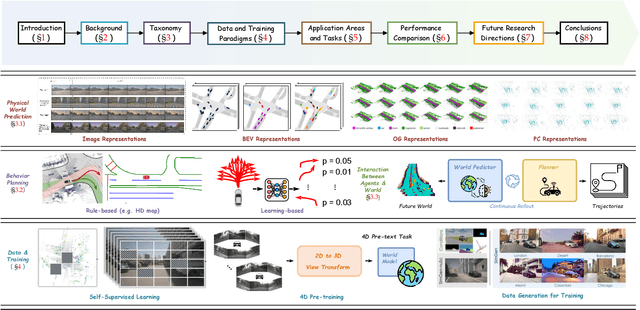
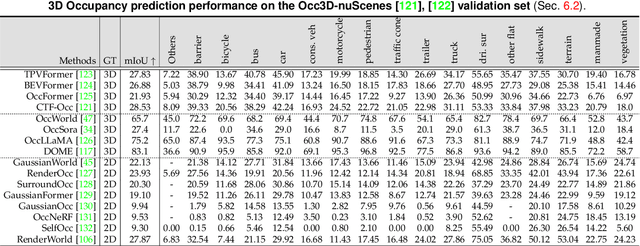

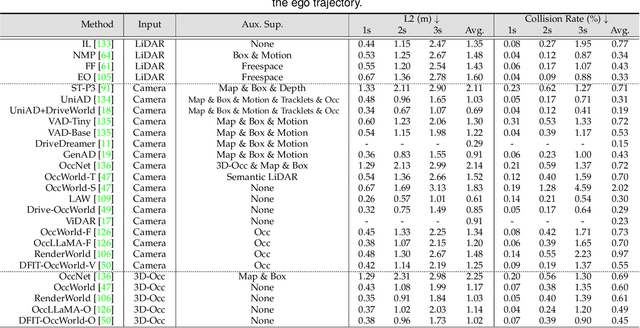
Abstract:Recent breakthroughs in autonomous driving have revolutionized the way vehicles perceive and interact with their surroundings. In particular, world models have emerged as a linchpin technology, offering high-fidelity representations of the driving environment that integrate multi-sensor data, semantic cues, and temporal dynamics. Such models unify perception, prediction, and planning, thereby enabling autonomous systems to make rapid, informed decisions under complex and often unpredictable conditions. Research trends span diverse areas, including 4D occupancy prediction and generative data synthesis, all of which bolster scene understanding and trajectory forecasting. Notably, recent works exploit large-scale pretraining and advanced self-supervised learning to scale up models' capacity for rare-event simulation and real-time interaction. In addressing key challenges -- ranging from domain adaptation and long-tail anomaly detection to multimodal fusion -- these world models pave the way for more robust, reliable, and adaptable autonomous driving solutions. This survey systematically reviews the state of the art, categorizing techniques by their focus on future prediction, behavior planning, and the interaction between the two. We also identify potential directions for future research, emphasizing holistic integration, improved computational efficiency, and advanced simulation. Our comprehensive analysis underscores the transformative role of world models in driving next-generation autonomous systems toward safer and more equitable mobility.
Human-Object Interaction Detection Collaborated with Large Relation-driven Diffusion Models
Oct 26, 2024



Abstract:Prevalent human-object interaction (HOI) detection approaches typically leverage large-scale visual-linguistic models to help recognize events involving humans and objects. Though promising, models trained via contrastive learning on text-image pairs often neglect mid/low-level visual cues and struggle at compositional reasoning. In response, we introduce DIFFUSIONHOI, a new HOI detector shedding light on text-to-image diffusion models. Unlike the aforementioned models, diffusion models excel in discerning mid/low-level visual concepts as generative models, and possess strong compositionality to handle novel concepts expressed in text inputs. Considering diffusion models usually emphasize instance objects, we first devise an inversion-based strategy to learn the expression of relation patterns between humans and objects in embedding space. These learned relation embeddings then serve as textual prompts, to steer diffusion models generate images that depict specific interactions, and extract HOI-relevant cues from images without heavy fine-tuning. Benefited from above, DIFFUSIONHOI achieves SOTA performance on three datasets under both regular and zero-shot setups.
 Add to Chrome
Add to Chrome Add to Firefox
Add to Firefox Add to Edge
Add to Edge